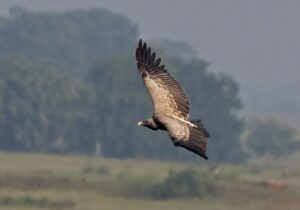News flashed this week as one striking, pink-feathered aquatic bird appeared in Wisconsin. Meanwhile, novel sightings of other species occurred in regions as far-flung as India and interior Alaska.
No one had seen a Roseate Spoonbill in Wisconsin since before the U.S. Civil War, over 150 years ago. The birds typically never range above the Gulf of Mexico. Tropical Limpkins also appeared in the temperate, northern state, as well as in nearby Pennsylvania.

A limpkin. Photo: JamieDrakePhotos via Flickr
Other odd bird sightings
One young birder spotted an Asian species at a lake in the middle of Alaska, and Indian enthusiasts scouring inland areas of Gujarat noted pelagic birds typically bound to the coast and open water.
In the latter case, it was clear what caused the birds’ displacement: Cyclone Biparjoy, which menaced the country’s western coast in June. Avian biologists call the phenomenon “fallout,” and cases are well-documented.
However, bigger-scale changes in weather patterns could be a uniting factor among unusual bird sightings worldwide.
Migratory birds (which account for about a fifth of all bird species) respond to an elaborate calculus of atmospheric conditions to time and geolocate their cyclical habitations. Various weather cues, internal timing mechanisms, and seasonal wind streams generated by reliable temperatures all inform their habits.
In one example described by the Vermont Audubon Society, fluctuating temperatures are affecting the life cycles of migratory birds’ food sources — insects.
Migrants are vulnerable to disruption
Phenology is the study of cyclic and seasonal natural phenomena. One theory currently undergoing heavy testing is that the timing of insect emergence (the final transition in an insect’s life, which produces the adult) is changing globally in response to temperature. That could be creating “phenological mismatches,” as one study put it, between insects and their predators, such as birds.
If that’s the case, it would strongly impact birds with significant migration behavior.
“Birds that travel the farthest undergo extreme physiological changes including shrinking internal organs and doubling their body weight to prepare for their journey,” the Vermont Audubon Society explained. “The extra foraging time needed to pack on fat and muscle and the dangers posed by predators, severe weather, and human-made structures leave migrating birds highly vulnerable.”
It’s just one example of how migrating birds could respond to climate change, and wind up in unusual places. Here during one of the most exceptionally hot summers in recorded history, it’s easy to draw the inference that birds could be exploring new territory.
Local hero
At least as far as the spectacle this behavior could produce, birdwatchers aren’t complaining. Birders in Wisconsin, for instance, hadn’t seen a Roseate Spoonbill in 178 years.
Today was an unforgettable day! Spotted the first Roseate Spoonbill in over 150 years in Wisconsin with fellow birders! 😱 Such a rare visitor to the Badger State! Respectfully cropped images to cherish this incredible encounter. #WiscoBirder #BirdTwitter 📷🦩👐🏾🖤 pic.twitter.com/D61qDDcLDQ
— Dexter Patterson (Wisco Birder) 📷👐🏾🖤 (@wiscobirder) July 30, 2023
“I’ve been on cloud nine for days now,” Logan Lasee, who first reported the record sighting, said in a statement as reported by IFLScience. “I check almost every day now to see if it’s still around. I’ve had people who knew I’m the guy who found it come up to me. I felt kind of like a celebrity the last few days.”
It remains to be seen whether birders like Lasee continue to enthuse over novel appearances like the spoonbill’s. If it indicates a disruption, it will likely force some adaptation — i.e. another stressor.
For its part, the Audubon Society concluded an extensive report with optimism. In just 40 years, it notes, birds across North America seem to be growing smaller bodies and longer wings. The adaptations could help the 52 species in question shed body heat faster, among other less-understood benefits.
“While the shifts we are observing highlight the added stressors birds must face, their ability to rapidly adjust behavior in response demonstrates an impressive resilience,” the Society wrote. “Being witness to nature actively trying to prevail certainly brings hope for the ability of the creatures we love to withstand the changes ahead.”






